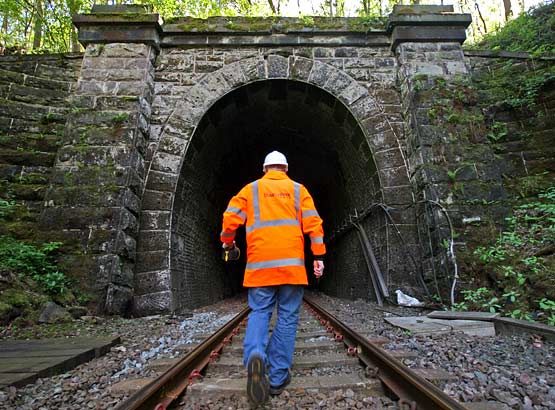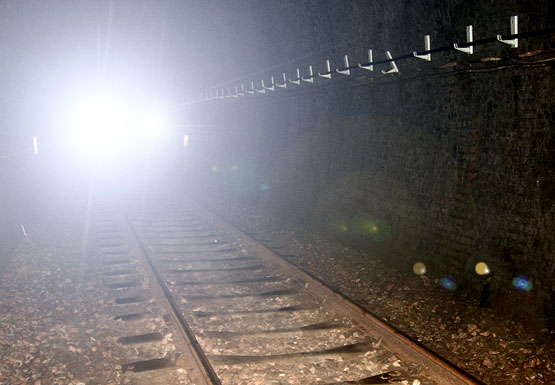|
April marked the first leg of DeathBy’s world tour. In the interest of fairness, Jungle Ron and I have long been of the view that health and safety’s rabid hysteria should infect the globe more evenly. Why should the Yanks remain untouched? So we arranged flights across the pond to spread the word. Unfortunately, swine flu passed through US immigration control at about the same time as we did, stealing everyone's attention. There was also a cock-up on the organisational front, resulting in your author flying home from New York’s JFK just as Jungle was dropping in. Our Trainee Assistant Logistics Co-ordinator (Cushioning Division) has fallen on his foam-rubber sword, slightly spraining his ego.
Still, we did manage to find ourselves in the same place at the same time (and wearing identical wellies) later in the month when we plunged into a tube of gloom on the North Yorkshire coast. Sandsend’s 1,652-yard tunnel - formerly part of the single track railway linking Loftus with Whitby North Cliff - last resounded to the clickety-clack of coaching stock on 5th May 1958. It’s in fair condition half a century on, save for occasional bulges in the lining and a carpet of thick, orange sludge beyond the third shaft.
As light from the portal dimmed, I tried to imagine what the tunnel would have been like as a workplace in those distant days when trains scuttled through it. Notwithstanding its surfeit of refuges, it can’t have been much fun when a labouring locomotive wiped the sweat from your nose, belching smoke in your face as it did so. Of course, today’s times are more enlightened - entering a tunnel is now a non-starter unless the lines through it are blocked……except in an emergency.

I was reminded of some prickly exchanges around the table at a Track Safety Strategy Group meeting when rule G1.6.3(d) came up for discusssion. This, you will immediately recall, requires the person despatched to place detonators in an emergency to walk right through any tunnel he encounters if the protection distance of 1¼ miles falls within it.
There were two camps. The group’s practitioners - few in number and generally quite muted - felt that this was a flawed instruction as it effectively demanded that trackworkers endanger themselves - in itself, contrary to the rules. This was a position supported by the union. However, the managerial office wallahs - who could be reassured that here was a function they would never have to perform - considered it perfectly reasonable and, as ever, got their way.
Reasoned argument rarely claims victory where the Rule Book is concerned. Culture is far too engrained. Those in a position of authority only give ground if it suits them. But, for the hell of it, let’s hear the argument anyway.
It’s 1956, or shortly before eight o’clock. You and your gang are admiring the coastal views 200 yards north of Sandsend Station when a tree slides down the embankment and blocks the line. Jenny Agutter is hobnobbing at the Rail Sustainability Masterclass so it falls on the COSS’s shoulders to take charge. He points Albert in a southerly direction, towards the signal box where the nearest bobby is resting; you have a flag, lamp and dets thrust into your hand and told to head north, from where the next train is expected. Soon you find yourself gazing through the portal into a threatening world, isolated in a land with no mobile phone coverage.
|
| Jenny Agutter is hobnobbing at the Rail Sustainability Masterclass so it falls on the COSS’s shoulders to take charge. |
|
You have walked almost a mile; the tunnel is almost a mile. It will take you 20 minutes to reach the other end during which time you will almost certainly encounter a train. Despite this, the rule compels you to set forth into the darkness, even if you don’t where the refuges are (or indeed if there are any). Why do they want you to do this?

Let’s say the linespeed is 60mph and the vehicle which is shortly due to emerge into daylight is a typical DMU. If the driver applies the emergency brake on his exit from the tunnel - having exploded three dets and seen your handsignal - his train will stop several hundred yards short of the obstruction. Fact is, in this specific situation, the distance of 1¼ miles is a serious gilding of the lily. By walking blindly into the tunnel, you are putting your own life on the line whilst delivering no safety benefit to the hoards on board the train. Yet again, sensible assessment of what is actually needed falls at the feet of ‘one-size-fits-all’ - the managerial philosophy which makes their lives much simpler.
But there’s more. Whilst you were fighting your way through the trackside jungle, what action were you expected to take if the rails started ringing, signalling the approach of a train? According to G1.6.3(b), “you must place three detonators immediately and show a red hand danger signal…”.
The train is hurtling towards you at 60mph; it’s 400 yards away. It will be passing you in 14 seconds time.
Start the clock.
First, shuffle through your pocket for the plastic canister, unscrew the lid and tease out a detonator. Make sure you’re wearing gloves as the lead straps are a health hazard. Check it’s still in date. Carefully bend the straps back, step onto the sleeper ends and secure the detonator to the railhead.
Now march 20 yards up the line and repeat the process. Then pace out another 20 yards and do the same again. As the nearest yellow peril is about to explode and embed itself in your leg, scurry 30 yards away to evade the shrapnel.
Next, display a hand danger signal to the driver. Unfurl your red flag, raise both arms above your head or, in darkness or poor visibility (whatever that is), show a red light or wave any light vigorously. Replacement torch batteries are available from Sandsend village store.
Stop the clock.

For experimental purposes, I once asked my balding colleague to carry out this process whilst I monitored a stopwatch. On dry ballast with a prevailing wind, it took him 40 seconds. In reality, the train would have pulped him as he laid the first det.
Every step taken without the line being protected is, potentially, a step closer to disaster. Dets should be placed at the first effective location, not at some distance determined back in the days of steam. It might have gone unnoticed in The Treacle Tower but the world has changed since then; despite this, the rules remain steadfastly the same. Continued publication doesn’t make them right.
There are those who will say that this really doesn’t matter. In the era of mobile communications and modern signalling, this worst-case scenario is unlikely to rear its head. But doesn’t that miss the point? Surely, if a rule’s worth having, it ought to stack up. It’s against these missives that trackworkers will be measured when things keel over sideways. And there’s something morally corrupt about an instruction which drives someone into danger without legitimate cause.
Story added 1st June 2009
|